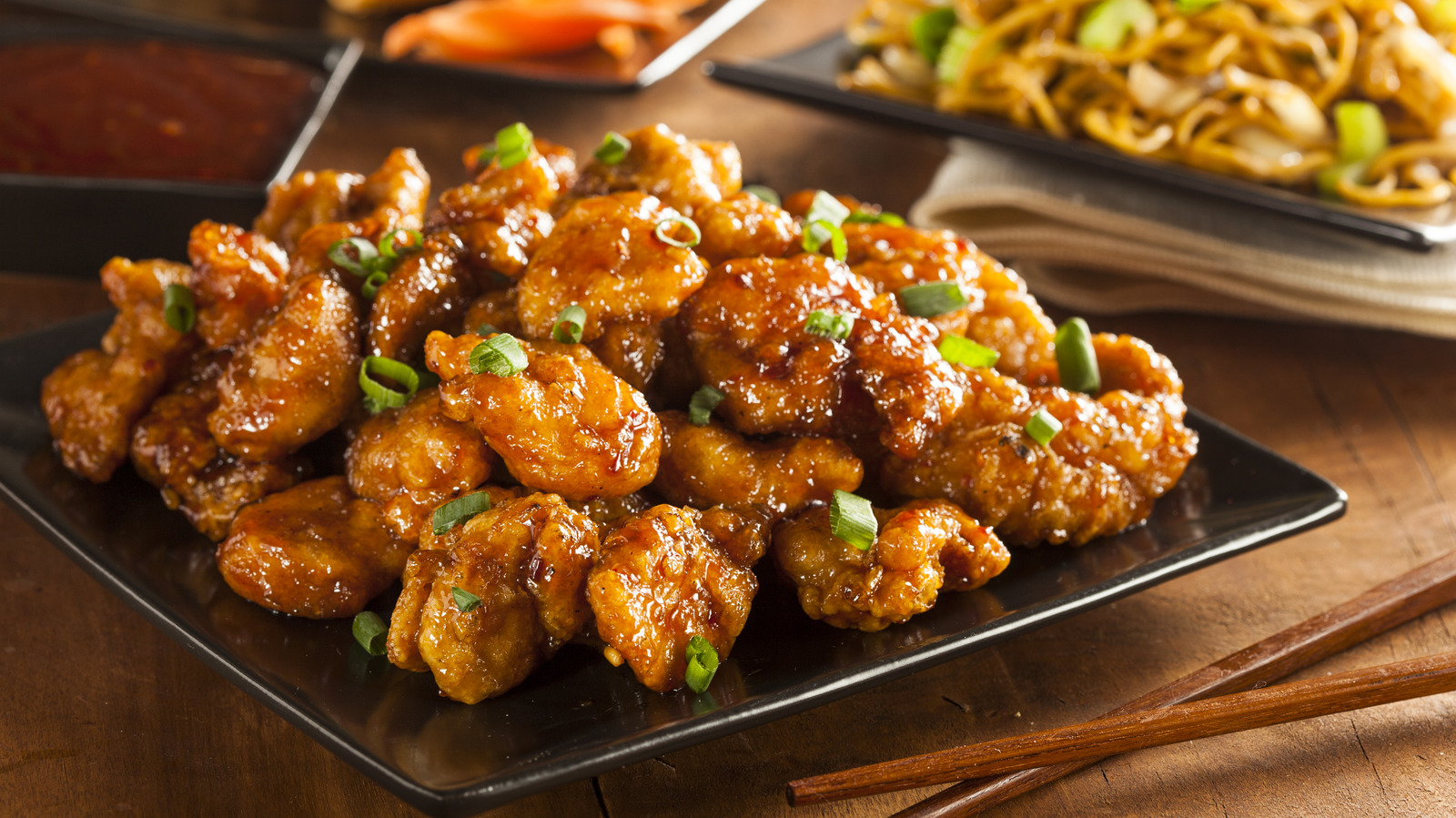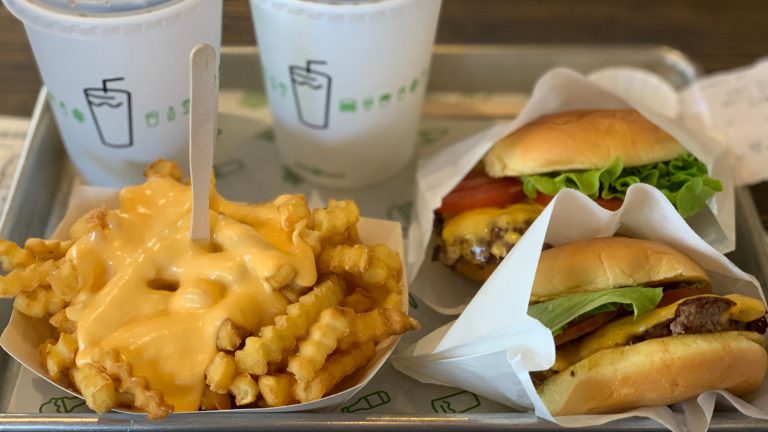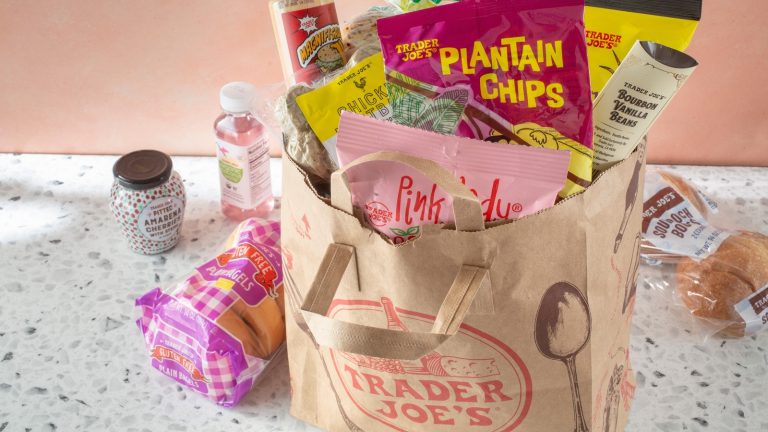We may receive a commission on purchases made from links.
From sesame chicken to chop suey, the intersection of Chinese and American cuisine has given birth to varied delights — and orange chicken is no different. Dating back to the late 1980s, the bone-in variation of the original Chinese recipe has been Americanized with boneless nuggets. However, the hallmark of its flavor profile endures. Today, the gilded crispiness of fried chicken tossed with a caramelized coating of orange sauce makes for a savory-yet-sweet experience that your dinner guests won’t forget anytime soon.
Despite being a mainstay on every Chinese takeout menu card, whipping up your own batch of orange chicken makes for a rewarding experience. After marinating half-inch cubes of boneless chicken with egg whites and cornstarch, the pieces are deep-fried and tossed with a thickened glaze made from fresh orange juice, orange zest, sugar, and soy sauce.
While the basics of deep-frying chicken and preparing the glaze are easy to follow, it helps to pay caution to the finer details that can make or break your dish. How long should you wait after frying the chicken to douse it with sauce? How can you fix an overly acidic orange sauce? And how do you redeem the sauce if it turns cloyingly sweet? Answers can be found with chef Martin Gomes, head chef of Cantan, and chef Prem Kumar Pogakula, executive chef at The Westin Hyderabad Mindspace. Stay one step ahead of every mistake that can thwart your plans of takeout-worthy orange chicken by borrowing from their lived-and-learned experiences.
Using the wrong cut of chicken
You read the recipe like a hawk, followed all the instructions and yet, some parts of the chicken turned up raw while others were inexplicably overdone. It might be time to re-examine your choice of chicken. Not all cuts of chicken are created equal — some lend themselves well to pan-frying, while others better retain their moisture through frying.
Since orange chicken calls for the latter, you’ll want to reach for chicken thighs when cooking. Generally more tender and less prone to drying, chicken thighs serve as a worthy candidate. Chef Gomes concurs. “Since the recipe requires the chicken to be cooked at high temperature, you’ll find that chicken thighs are an ideal choice due to their higher fat and collagen content,” he says.
Other cuts, meanwhile, may not stand you in good stead. “Chicken breasts can dry out easily,” cautions chef Pogakula. As a lean cut of meat, chicken breast doesn’t have much by way of fat content to serve as a layer of insulation. Without this helpful shield, the temperature of this cut changes rapidly when it’s heated, making it prone to dryness and overcooking.
Over-marinating the chicken
Once you have your cut of chicken squared away, it’s time to go elbow deep in marinade. However, moderation is of the essence here, as over-marinating chicken is a common mistake. “If the chicken becomes mushy or the marinade’s flavor becomes too strong,” chef Gomes warns. “It’s a sign of over-marinating.”
So, how can you glean if you’ve taken an overzealous approach to the marinade? Chef Pogakula has found that if the chicken takes on a grayish hue, it can be a tell-tale sign it’s been marinated more than necessary. “If you marinate for more than six to eight hours, the chicken can take on a mushy texture as the proteins are broken down,” he explains.
However, all hope is not lost yet. In case the fam decides to dine out and the chicken needs to be made at a later point of time, it’s possible to salvage the situation without a complete do-over. Simply rinse the chicken under cold water and pat it dry to remove excess marinade. The chicken can then be seasoned as needed when you plan to cook the dish next.
Under-marinating the chicken
Over-marinating the chicken will negatively impact its texture, but an underwhelming approach to the marinade won’t turn out a restaurant-quality dish either. We all have those days when time is a scarce resource, but not giving the chicken enough time in the marinade will result in a flavorless dish.
To ensure your chicken doesn’t veer into bland territory, chef Gomes recommends marinating it for a minimum of 30 minutes. If you’re planning on maintaining fidelity to the original Chinese recipe, he recommends dunking bone-in pieces in the marinade for at least an hour.
So, what difference does half an hour make for ensuring the crispiness of the chicken? The credit goes to the traditional Chinese technique of velveting. By dipping the chicken pieces in a mixture of egg whites and cornstarch for half an hour, you’ll be able to create a protective coating. This shield locks in the moisture and keeps the chicken from becoming dry when subjected to high temperatures while deep-frying.
Using an improperly seasoned wok
If your deep-fried chicken is imbued with an inexplicably metallic taste, it’s time to assess the seasoning of the wok. If you’ve spent some time in the kitchen, the mechanisms of seasoning probably won’t come as fresh news. By creating a thin, protective layer on the surface of cast iron or carbon steel, you can prevent the wok from rust and corrosion; making it easier to work with.
However, this layer of protection can get corroded over time, especially when working with acidic foods such as vinegar and lemon. If the seasoning wasn’t done well or hasn’t been cared for, rust spots can develop on the surface of the wok. This can impart a metallic taste to the chicken during deep-frying which will detract from the vibrant, tangy flavors that orange chicken is known for.
To ensure you stay one step ahead, chef Pogakula recommends keeping an eye out for some warning signs, such as signs of unevenness in the color of the wok. “Good woks should be dark and even, while light or patchy areas mean the seasoning isn’t finished,” he says.
Using the wrong temperature of oil for frying
Once your chicken has gotten all cozy in the marinade for the appropriate amount of time, the next stage involves deep-frying the pieces to ensure a silken crunch. However, this is where the wrong temperature of oil can derail your plans. Too hot, and you run the risk of scorching your carefully marinated pieces. Too cold, and you could end up with a mouthful of grease with every bite.
Not sure how to strike the right balance? Chef Pogakula likes to play it by the numbers. “If the oil is hotter than 400 degrees Fahrenheit, the chicken pieces will burn on the outside while staying raw on the inside. If the oil is colder than 325 degrees, the chicken will soak up oil and become greasy,” he says. As a rule of thumb, he likes to opt for a temperature of 350 to 375 degrees when deep-frying chicken.
If you’re aiming for chef-style precision, a deep-frying thermometer makes for a handy investment. A classic analog thermometer will allow you to monitor the temperature of the oil, with modern iterations including colored markings for frying chicken and other food items. Need to check the temperature in a pinch? Pogakula recommends dropping in a small piece of chicken or a bit of flour. “If it sizzles right away, you’re good to start cooking,” he advises.
Using incorrect oils for frying
It’s impossible for the words ‘smoke point’ to not pop up in any discourse on deep-frying — and with good reason. The smoke point is the temperature at which the compounds in the oil start to break down and take on a bitter taste. As you may have guessed, opting for oils with low smoke point is a common mistake when deep-frying chicken.
Prime on the list of culprits is olive oil, cautions chef Pogakula. “With its lower smoke point, it tends to get bitter after heating,” he says. Chef Gomes also recommends steering clear of flaxseed, walnut, and fish oils, as they break down easily at high temperatures.
So, what should you reach for instead? USDA guidelines rate peanut, safflower, and soybean oils as ideal candidates for deep-frying due to their high smoke point of 450 degrees. Grapeseed, canola, corn, olive, and sesame seed oils follow closely behind with smoke points that clock in above 400 degrees. “Sunflower, rice bran, and vegetable oil are also ideal for frying due to their high smoke points and neutral flavors,” Pogakula says.
Not using the right frying technique
With your wok appropriately seasoned and your oil heated to the right temperature, the rest of the deep-frying process may sound elementary. Still, it helps to pay close attention to deep-frying mistakes that can turn the golden brown crust of your dreams into a lumpy, soggy mess.
The first thing that chef Gomes wants you to pay attention to is the temperature of the chicken. “Avoid frying cold chicken to prevent a sudden drop in the temperature of the oil, which can result in uneven cooking,” he says. It’s also important to shake off excess flour before dipping the chicken in the oil. “This helps prevent excessive bubbling and ensures even frying,” chef Pogakula intones.
In the quest for an evenly fried crust, you’ll also want to ensure that your chicken pieces are flipped at a reasonable pace using a pair of tongs. “Flip pieces occasionally every two to three minutes for even browning,” Pogakula says. As tempting as it may seem to get all the chicken pieces done in one batch, overcrowding the wok can be counterproductive. When too many chicken pieces are placed in the wok at the same time, it can cause a significant drop in the temperature of the oil. Getting the oil back to your desired temperature will mean that your cooking time will be dialed up — which is the last thing you want when hustling to get dinner ready in time.
The orange sauce is too acidic
Getting your chicken fried correctly is half the battle won. The orange sauce will now take over as the star of the show — but any imbalances in the flavor profile of the sauce are hard to get away with. If you’re detecting an overly acidic taste from your orange sauce, it likely stems from using either too much citrus or not enough sweetness.
While orange sauce is known to hit your palate with a tart, tangy flavor profile, there is such a thing as too much of a good thing. If the orange sauce has veered beyond tangy and instead tastes immensely sour with a lip-puckering sensation, it’s time to look for remedial measures.
The easiest way to balance an overly acidic orange sauce is — you may have guessed it — to head toward the opposite end of the spectrum. “You can add sugar, honey, and a touch of cream to balance the taste. You can even consider adding a pinch of baking soda to neutralize the acidity,” chef Gomes advises.
The orange sauce is too sweet
Sugar and tanginess are known to pack a delicate one-two punch which gives orange sauce its highly coveted taste. However, a generous hand while tipping sugar into the sauce can lead to an overpowering, cloying aftertaste.
As a rule of thumb, chef Prem Kumar Pogakula advises tasting the sauce before adding it to the chicken to adjust seasoning as needed. If the sauce is too sweet, it likely has too much sugar or not enough acid. If your sauce has strayed into overly sweet territory, all hope is not lost. “Adding a splash of vinegar or fresh orange juice can help balance the sweetness,” he says.
The tartness of citrus fruits makes them the first port of call for reducing the sweetness of a sauce — how incredibly fortuitous that you should have some at hand when making orange chicken. As an acidic agent, vinegar also contributes a dose of tartness that will counterbalance the sweetness of the sauce. To ensure your sauce doesn’t become overly acidic, start with just a splash of vinegar and graduate to one teaspoon as necessary.
Zesting the orange incorrectly
While orange juice exudes considerable main character energy in the sauce, orange zest also has an important role to play. However, if you’re observing a bitter taste from the orange zest (not to be confused with tangy), you’ll want to brush up on your zesting skills.
On paper, the process of zesting sounds far from rocket science: Simply run the skin of the orange against the angled holes of a zester. However, applying too much pressure can lend a bitter taste to your produce. The colorful rind of the orange holds all the flavorful oils, but the white pith underneath has a bitter taste that can overpower the zest. When zesting with too much force, you might end up breaking through the rind and running into the inner pith.
The correct technique involves a gentle approach to zesting. As chef Gomes put it: “Use a light touch and avoid grating too deeply.” By rotating the fruit regularly, you can avoid wearing one side of the fruit down too much and thereby steer clear of the bitter pith that lies in wait underneath.
Coating the chicken with sauce too soon
If you’ve read your fair share of orange chicken recipes, you’ve likely come across the words “serve immediately” denoted after tossing the chicken in the orange sauce. As tempting as it might seem to get a headstart on the dish before your dinner guests arrive, pouring the sauce on the fried chicken too soon is a mistake that can prove perilous.
When the chicken is not cooled sufficiently, it will both melt the sauce and impact the crispiness of the crust. The opposite is also true: When the chicken is properly cooled after frying, the sauce will adhere better and prevent the chicken from becoming soggy. Chef Martin Gomes advises, “To maintain crispiness, allow the fried chicken to cool for at least 10 to 20 minutes on a wire rack before coating it with sauce and serve immediately to avoid sogginess.”
Wire racks are a must-have in every baker’s arsenal, but it also helps to have one on hand when working with fried chicken. The raised grid of a wire rack allows 360-degree circulation of air so the chicken can cool evenly. When the steam released from the hot food is allowed to circulate freely, it prevents condensation from turning the crust soggy.
Waiting too long to apply the sauce
It can be a delicate balance to ensure the sauce adheres to the chicken without making the crust soggy. But waiting too long won’t work in your favor either, as the thickened sauce can turn clumpy when poured over cold chicken. “When the chicken is coated with sauce after it has cooled down too much, it can lead to a less appetizing texture,” chef Pogakula cautions.
Once you’ve allowed the fried pieces a maximum resting time of 20 minutes, toss the fried chicken pieces lightly with sauce in a skillet. Contrary to popular belief, the art of tossing food with sauce doesn’t lie in flipping the food high in the air. Instead, it helps to use a back-and-forth motion: push the pan forwards and then pull it back in a quick motion. As the food falls back in on itself, it will be coated evenly with sauce.
Not reheating orange chicken the right way
If you like to work in advance, it might seem all too easy to pop the chicken into the microwave before serving, but the fallout comes in the form of a soggy crust. Microwaves primarily work by heating the water content in food. The steam produced from the boiling water is a surefire recipe to turn the crispy crust of your chicken into a soggy mess.
If you do feel partial to the microwave, Country Living advises reheating the dish in brief spans of 20 to 40 seconds and flipping it over after each burst. However, in chef Pogakula’s book, the ideal way to sidestep reheating mistakes is to place it in a preheated oven at 400 degrees. “Place it on a wire rack over a baking sheet for 8 to 10 minutes. You can also reheat the dish on a skillet on medium-low heat with a lid placed on until it has heated through.”





